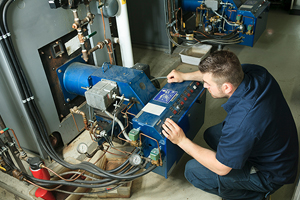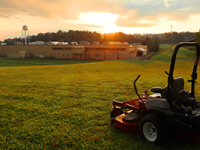
How Maintenance Strategies Can Affect the Lifespan of Power Plant Parts
 There's more than one way to maintain an asset. Power plant and maintenance managers implement various strategies to prepare for and respond to maintenance issues. While there isn't just one correct way to maintain your machines, each solution offers its advantages and disadvantages.
There's more than one way to maintain an asset. Power plant and maintenance managers implement various strategies to prepare for and respond to maintenance issues. While there isn't just one correct way to maintain your machines, each solution offers its advantages and disadvantages.
Selecting your power plant system's optimum maintenance strategy can be the difference between significant downtime and smooth operation to prevent unplanned outages. Note that the best approach for some machines will be different than others. Here are the three most popular and effective strategies that power plant leaders use to maintain their equipment on the plant floor.
Corrective maintenance
Often referred to as "crisis management," this type of maintenance is designed to respond to power plant equipment issues. With this kind of maintenance, repairs are completed when there is a noticeable problem with functionality or condition. For example, if a combustion turbine valve is leaking, maintenance leaders should plan an immediate repair to limit downtime. The complication with this "run-to-failure" approach is the higher probability of unplanned maintenance activities and shutdowns. This type of maintenance also encourages high replacement-part inventories, so power plants that utilize corrective maintenance need to have a high volume of spare parts. While this may not seem like the most efficient strategy, it can still be the most effective type of maintenance for specific components.
But what does this strategy mean for the lifespan of power plant parts? Unplanned maintenance repairs are a result of parts that have gone through wear and tear. A corrective approach could be disastrous for a power plant if backup parts are not available. However, it's possible to have a seamless transition with the proper preparation and avoid costly downtime.
No matter what maintenance strategy your plant utilizes, having instant access to replacement parts is essential to limit downtime. Parker's Valve Service program aims to replace and refurbish aging fuel and water control valves on 7E and 7F turbines. Due to the many years of service that these valves have seen, wear and corrosion may be reducing their effectiveness.
Preventive maintenance
This time-based maintenance is the shift from unplanned to planned maintenance activities. While corrective maintenance is based on a reactive approach, preventive maintenance takes on a more proactive approach. Scheduled maintenance inspections are intended to reduce or eliminate machine failures on the plant floor.  Depending on the frequency of the planned inspections, routine maintenance can cut downtime and lessen the severity of unplanned outages.
Depending on the frequency of the planned inspections, routine maintenance can cut downtime and lessen the severity of unplanned outages.
Plants that utilize a preventative maintenance strategy are well prepared; however, it could result in unnecessary downtime. If machines and equipment are running efficiently, unneeded inspections can disrupt a plant's production flow. Lost uptime and revenue can be enough reason to use a different maintenance approach.
The bright side to a preventive maintenance approach is fewer unplanned outages, which can result in less wear and tear on an asset. However, it’s important to realize that equipment can still malfunction between scheduled repairs, so it’s still safe to stock up on your parts inventory.
Predictive maintenance
Predictive maintenance, also known as condition-based maintenance, is the most technologically advanced form of maintenance that replaces arbitrary inspection check-ups. Instead of planning inspections when your equipment is functioning at peak performance, predictive maintenance allows your machines to alert you when repairs are needed. Typically, this would be done by monitoring system parameters like pressure, flow rate, or temperature to look for changes over time, indicating that a component is nearing the end of life or needs repair.
Operating costs for this type of maintenance can be expensive due to the instrumentation required to study the system, but it is likely more than offset by reducing unwarranted scheduled inspections and unplanned machine failures. However, predictive maintenance is not always worth the investment depending on the machine or equipment.
This form of maintenance can be great for the longevity of machine parts, as the reduction of failures cuts down on repairs.
Preparing for planned outages
Whether planned or unplanned, outages can impact any plant. Due to the unpredictability of an unplanned outage, the proper preparation isn't often implemented. So, when a seasonal planned outage occurs, it's essential to make sure your team is ready. But how do you prepare for an outage, and what should you be thinking about?
-
Review reports for prior outages
Looking at past reports is the first thing to do when preparing for a planned outage. The purpose of preparation is to reduce downtime and increase efficiency, so it's always good to make contingency plans to learn from past issues. -
Perform a pre-outage data review
It's important to evaluate your operations before the outage to see the success of your post-outage overhaul. This assessment will also help find any abnormalities that you should include in the full scope of your outage. Create an initial benchmark to compare to your post outage production. -
Make sure your facility is properly equipped
After performing an in-depth evaluation of your plant floor, you'll want to make sure you have your facility equipped in advance. When you don't have the right equipment during an outage, you expose yourself to costly delays or potential injuries from using the wrong equipment. Parker can help set your plant up with spare parts for any aging assets at risk for failure.
There are many more steps to take when preparing for a planned shutdown, so make sure you leave yourself enough time to plan. It is recommended that you begin your shutdown preparation 18-24 months before the scheduled shutdown.
How Parker can help
Whether you are still preparing for the next planned outage or just operating your plant with one of the maintenance plans above, it is always a good idea to have spare parts on hand. And you can always rely on Parker to make that happen. For years, our goal has been to support power plants with technical and commercial information and to simplify the process of obtaining new products in the most efficient way possible.
 To address the potential issue at hand, it is important to identify the valves that need attention. These types of aging 7E and 7F turbine valves, which have been in service for 20-30 years, need an inspection. They include:
To address the potential issue at hand, it is important to identify the valves that need attention. These types of aging 7E and 7F turbine valves, which have been in service for 20-30 years, need an inspection. They include:
- Gauge selector valves
- Fuel isolation valves
- Water staging/isolation valves
- Fuel distribution valves
- Air purge valves
- Water proportioning check valves
Click here to learn more and download the FREE Valve Resource Guide.
 Article contributed by Mitch Eichler, business development manager, Hydraulic Valve Division, Parker Hannifin
Article contributed by Mitch Eichler, business development manager, Hydraulic Valve Division, Parker Hannifin
Related articles:
Time to Inspect and Service Your Combustion Turbine Valves
Replace Turbine Valves to Prevent Unexpected Shutdowns on the Plant Floor
Eliminate Maintenance Concerns on Gas Turbine Fuel Control Valve
Reduced Maintenance for Dual Fuel Gas Turbines With New Check Valve Design
Preventive Maintenance vs. Predictive Maintenance
Get Started on a Best Practice Maintenance Strategy | Infographic
Source: Parker Hydraulics Feed






